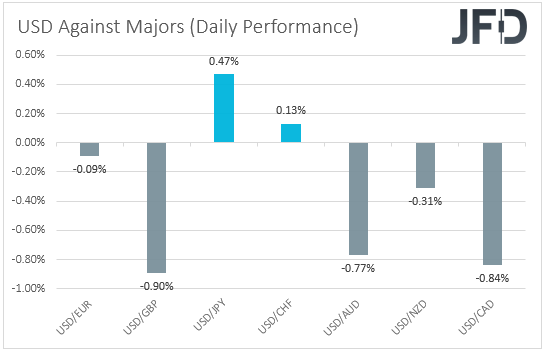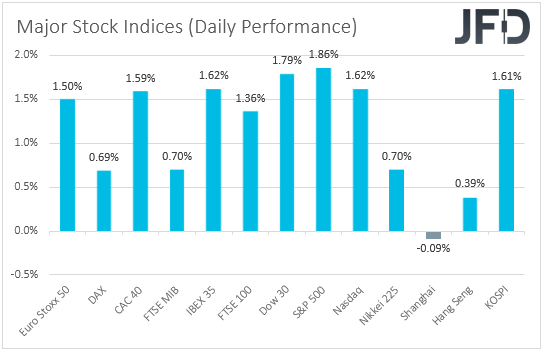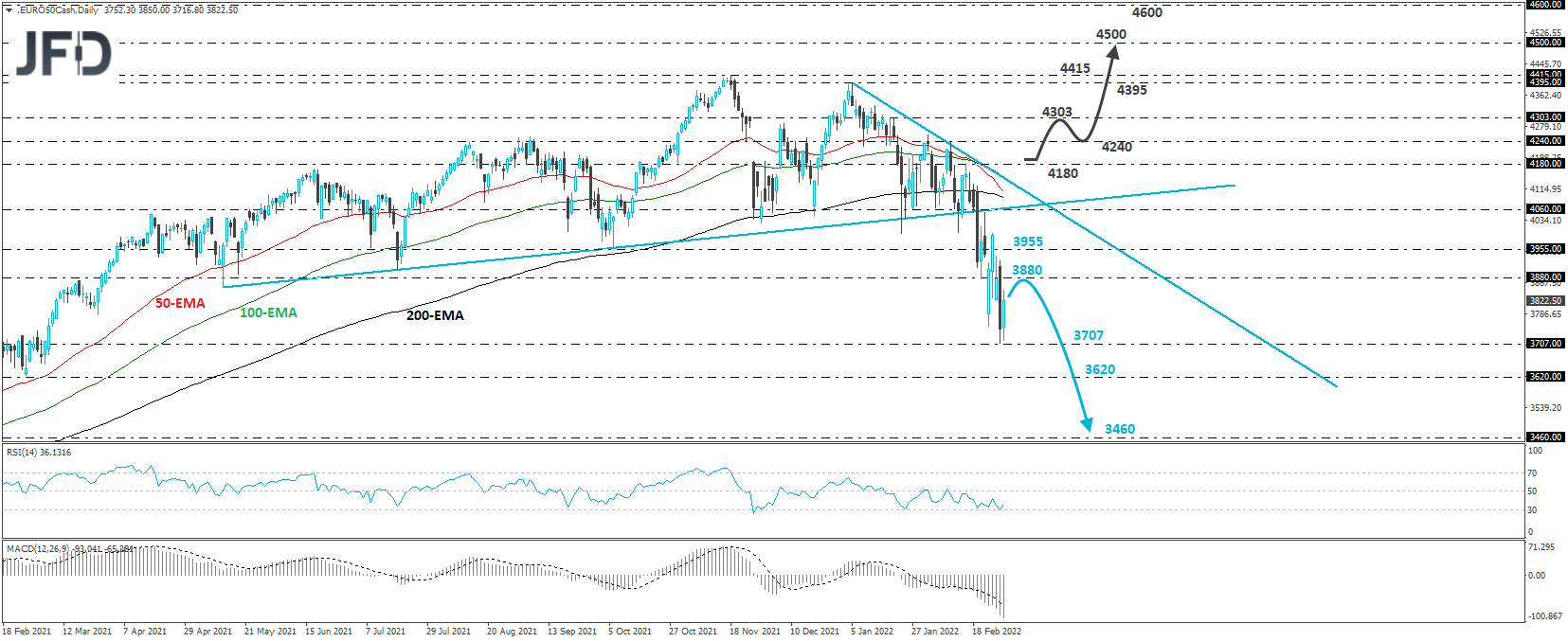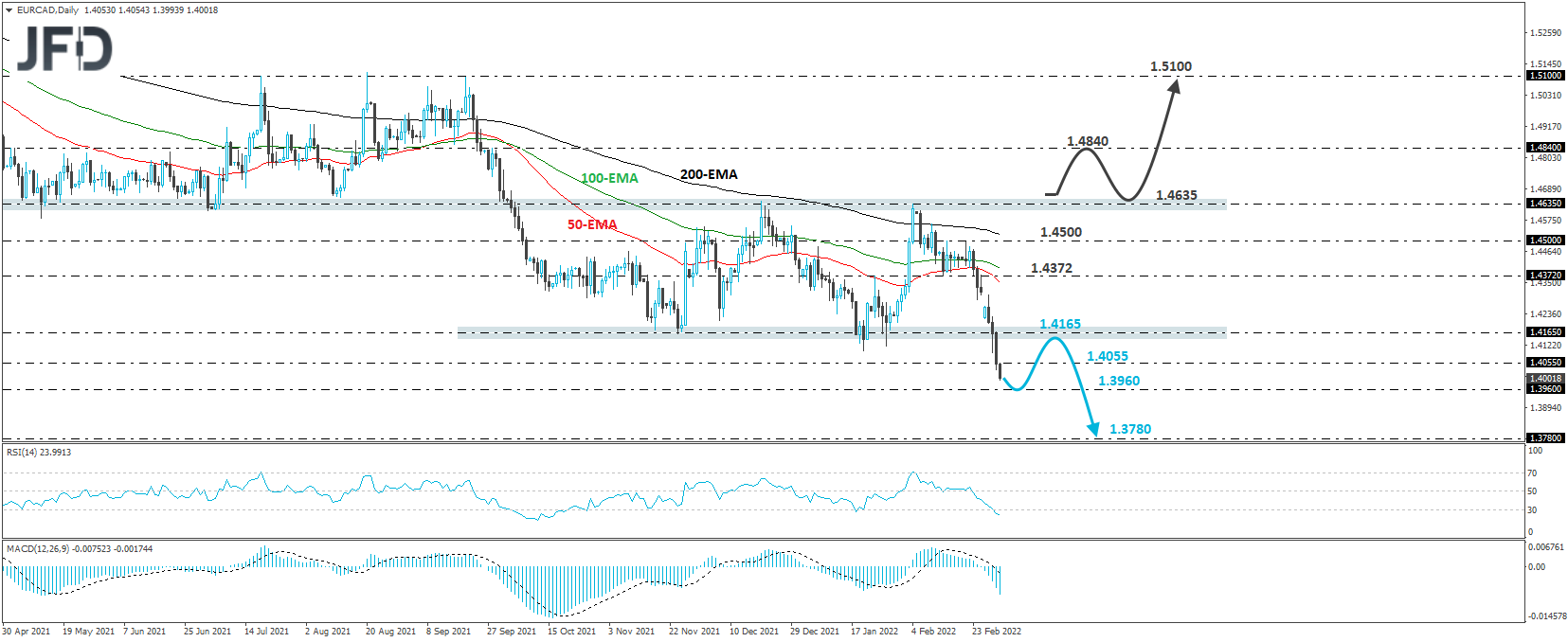Equities rebounded strongly yesterday, but with the crisis in Ukraine intensifying, we believe that this is just an adjustment bounce, which was also helped by Fed Chair Powell’s remarks. Testifying before the House Financial Services Committee, he said that he would probably support a quarter-point rate increase at the upcoming gathering.
We also had a BoC decision yesterday, with officials hiking by 25 bps as expected and sounding optimistic that more liftoffs may be in the works.
Fed Chair Powell Inclines Towards a 25 Bps Hike This Month
The US dollar pulled back against all but two of the other major currencies on Wednesday and during the Asian session Thursday. It gained only against JPY and CHF, while it underperformed the most versus GBP, CAD and AUD.

The weakening of the US dollar and the other safe-havens yen and franc suggests that investors’ risk appetite may have improved somewhat. Indeed, turning our gaze to the equity world, we see that major EU and US indices were a sea of green, with the positive mode rolling into the Asian session today.

With the war in Ukraine raging, we believe that this is just an adjustment bounce, which was also helped by Fed Chair Powell’s remarks before the House Financial Services Committee of the US Congress, and not the beginning of a positive reversal. As long as the Russia-Ukraine crisis continues, we will maintain the view that another round of selling could be possible at any time.
Now, as for Powell’s testimony, the Fed chief said that he and his colleagues will move forward with their plans to raise interest rates this month, but he added that he is “inclined to propose and support a 25 bps rate hike.”
This may have come as a disappointment to some market participants expecting a double hike. However, the probability of such an action has declined notably recently due to the ongoing tensions in eastern Europe. However, he also noted that he is ready to use larger or more frequent rate hikes if inflation does not slow, which keeps the door open to a steeper rate path than the market currently anticipates.
With oil prices surging yesterday, we don’t see this as a distant scenario. If the spike in energy and other commodity prices translates into further acceleration to the already high inflation, officials may need to indeed proceed with faster hikes.
This is in line with our view that when the geopolitical tensions ease, an aggressive tightening mood may keep a lid on any relief bounce in equities. Faster rate hikes mean higher borrowing costs for companies sooner, as well as lower present values, which could slowly start weighing on equities again.
Euro Stoxx 50 – Technical Outlook
The Euro Stoxx 50 cash index traded higher yesterday after it hit support at 3707 on Tuesday. However, the recovery was limited, and the index stayed well below both the prior upside support line taken from the low of May 13 and the downside one drawn from the high of Jan. 5. In our view, this keeps the near-term outlook negative.
Even if the recovery continues for a while more, we would expect the bears to retake charge from near the 3880 zone, or below the downside line drawn from the high of Jan. 5, and perhaps aim for another test at 3707. This will confirm a forthcoming lower low on the daily chart and may see scope for declines towards the low of Feb. 26, at 3620. If that barrier cannot halt the slide, we could see more significant extensions, perhaps towards the low of Jan. 29, at 3460.
On the upside, we would like to see a strong recovery back above 4180 before we start examining whether the outlook has turned back positive. This will signal the index’s return above the aforementioned diagonal lines and may see scope for advances towards the 4240 or 4303 zones, marked by the highs of Feb. 10 and Jan. 20, respectively. If market participants are not willing to stop there, we may experience extensions towards the peaks of Jan. 5 and Nov. 18, at 4395 and 4415.

BoC Hikes Rates as Expected, Sounds Optimistic for More
Yesterday, we also had a BoC decision, with the Bank hiking rates by 25 bps, to 0.50%, as was widely anticipated. In the statement accompanying the decision, officials said that Russia’s invasion of Ukraine “is a major new source of uncertainty,” adding that rising commodity prices would fuel further inflation. Still, new supply disruptions could weigh on global growth.
That said, officials also said that the rebound from the Omicron variant was “well in train” and that growth for the first quarter of 2022 now looks more solid than previously projected. This may have encouraged market participants to add to their bets regarding future rate hikes by this bank.
The Loonie was the second winner in line among the majors yesterday, perhaps due to that, but also due to the surging oil prices. The same catalysts are likely to keep it supported in the foreseeable future as well.
EUR/CAD – Technical Outlook
EUR/CAD tumbled yesterday, falling below 1.4165, which is the lower end of the sideways range the pair had been trading within since Oct. 4. The slide also took the rate below the 1.4055 barrier, marked by the low of Apr. 13, 2017, and now we are getting closer to the 1.3960 zone, marked by the inside swing high of Feb. 16, 2017. All this paints a very negative picture in our view.
The bears may decide to take a break after testing the 1.3960 zone, thereby allowing a rebound. However, as long as the rebound stays limited below the lower end of the aforementioned range, at 1.4165, we will see decent chances for another round of selling and another test near the 1.3960 zone. If the bears manage to overcome that hurdle this time around, we would expect extensions towards the low of Feb. 15, at 1.3780.
On the upside, we would like to see a decisive break above 1.4635, the upper end of the sideways range, before we assume that the bulls have gained complete control. This would confirm a forthcoming higher high on the daily chart and may initially pave the way towards the 1.4840 zone, marked by the peak of Sept. 28.
Another break above 1.4840, could carry larger bullish implications, perhaps setting the stage for advances towards the 1.5100 territory, which acted as a ceiling between Jul. 19 and Sept. 20.
As for Today’s Events
We get the final Markit services and composite PMIs from the Eurozone, the UK, and the US, which are, once again, expected to confirm their preliminary estimates.
Investors may pay more attention to the US’s ISM non-manufacturing index for February, which is expected to have ticked up to 61.0 from 59.9. We also have Fed Chair Powell’s testimony before the Senate Banking Committee.
